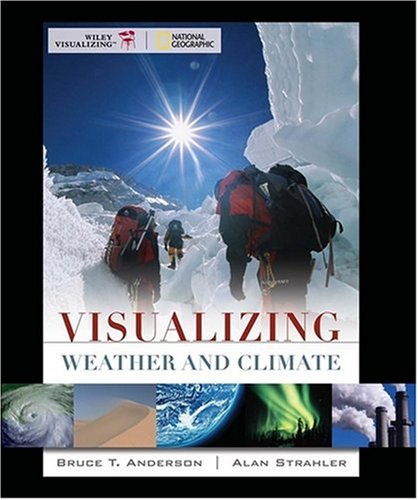Visualizing Weather and Climate 1st Edition by Bruce Anderson, Alan Strahler 9781118308851 1118308859
$50.00 Original price was: $50.00.$35.00Current price is: $35.00.
Visualizing Weather and Climate 1st Edition by Bruce Anderson, Alan Strahler – Ebook PDF Instant Download/Delivery: 9781118308851, 1118308859
Full download Visualizing Weather and Climate 1st Edition after payment

Product details:
ISBN 10: 1118308859
ISBN 13: 9781118308851
Author: Bruce Anderson, Alan Strahler
Visualizing Weather and Climate offers students a valuable opportunity to identify and connect the central issues of weather, climate, and the atmosphere through a visual approach. The text is organized around the premise that weather and climate are two interrelated and equally important influences upon environmental processes and human activity. As students explore the critical topics of weather and climate, their study of the role of the atmosphere is interwoven with the behavior of the oceans, land surfaces, ecosystems, and human activity. Visualizing Weather and Climate integrates visuals with text to elucidate concepts for students and solidify their understanding of them. The accessible format allows students to navigate through the material with greater ease.
Visualizing Weather and Climate 1st Table of contents:
1: Introducing Weather and Climate
Introducing Weather and Climate
Weather
Climate
Weather and Climate
Visualizing Weather and Climate
Graphs
Maps
Standard Measurements in Weather and Climate
2: The Earth’s Atmosphere
Composition of the Atmosphere
Radiatively and Chemically Inactive Gases
Radiatively and Chemically Active Gases
Ozone in the Upper Atmosphere
Ozone in the Lower Atmosphere
Temperature Structure of the Atmosphere
Troposphere
Stratosphere
The Ionosphere
Atmospheric Pressure and Density
How Air Pressure and Density Change with Altitude
The Ideal Gas Law
3: The Earth’s Global Energy Balance
Electromagnetic Radiation
Radiation and Temperature
Solar Radiation
Longwave Radiation from the Earth
The Global Radiation Balance
Geographic Variations in Energy Flow
Insolation Over the Globe
Net Radiation, Latitude, and the Energy Balance
Sensible and Latent Heat Transfer
The Global Energy System
Solar Energy Losses in the Atmosphere
Albedo
Counterradiation and the Greenhouse Effect
Global Energy Budgets of the Atmosphere and Surface
Climate and Global Change
4: Surface Temperature Global and Its Variation
The Earth’s Rotation and Orbit
Earth’s Rotation
The Earth’s Revolution Around the Sun
Solstice and Equinox
Variations in Insolation Over the Globe
Solar Heating of Land and Water
Air Temperature
Urban Heat Island
The Daily Cycle of Air Temperature
Daily Insolation and Net Radiation
Factors that Influence Daily Temperatures
The Annual Cycle of Air Temperature
Net Radiation and Temperature
Land and Water Contrasts
World Patterns of Air Temperature
Factors Controlling Air Temperature Patterns
Measurement of Air Temperature
Applications of Temperature Data
5: Atmospheric Moisture
Atmospheric Moisture and Precipitation
Three States of Water
The Hydrosphere and the Hydrologic Cycle
The Hydrologic Cycle and Global Water Balance
Humidity
Specific Humidity
Saturation Specific Humidity
Relative Humidity
The Adiabatic Process
Dry Adiabatic Rate
Moist Adiabatic Rate
Clouds
Cloud Forms
Fog
Precipitation
Precipitation Processes
Types of Precipitation
Measuring Precipitation
6: Winds
Winds
Measurement of Wind
Winds and Pressure Gradients
Winds and Pressure Gradients
Pressure and Temperature Gradients
Local Winds
The Coriolis Effect and Winds Aloft
The Geostrophic Wind
Cyclones and Anticyclones in Upper Air
Winds at the Surface
Cyclones and Anticyclones at the Surface
Divergence and Convergence
7: Global Atmospheric and Oceanic Circulation
Surface Winds
Global Wind and Pressure Patterns
Winds Aloft
Global Circulation at Upper Levels
Jet Streams and the Polar Front
Disturbances in the Jet Stream
Oceanic Circulation
Temperature Layers of the Oceans
Surface Currents
Deep Currents and Thermohaline Circulation
Heat and Moisture Transport
8: Midlatitude Weather Systems
Air Masses
Cold, Warm, and Occluded Fronts
Midlatitude Anticyclones and Cyclones
Anticyclones
Cyclones
Midlatitude Cyclones
Midlatitude Cyclones and Upper-Air Disturbances
Vorticity
Cyclone Tracks and Cyclone Families
Cold Air Outbreaks
9: Tropical Weather Systems
Tropical Cyclone Structure
Easterly Waves
Tropical Cyclones
Development and Movement of Tropical Cyclones
Tropical Cyclone Tracks
Impacts of Tropical Cyclones
Changes in Weather and Sea Level
Impacts on Coastal Communities
Changes in Tropical Cyclone Activity
10: Thunderstorms and Tornadoes
Thunderstorms
Air-Mass Thunderstorms
Mesoscale Convective Systems
Thunder and Lightning
Charge Separation
Thunder
Tornadoes
Tornado Characteristics
Tornado Development
Weather Conditions Leading to Tornado Formation
Tornado Alley
Tornado Destruction
Tornado Forecasting
11: The Global Scope of Climate
Factors Controlling Climate
Temperature and Precipitation Regimes
Temperature Regimes
Precipitation Regimes
Seasonality of Precipitation
Climate Classification
Overview of Climates
Dry and Moist Climates
Köppen Climate Classification System
12: Climates of the World
Low-Latitude Climates
Wet Equatorial Climate
The Trade-Wind Coastal Climate
The Wet-Dry Tropical Climate
Monsoon Climates
The Dry Tropical Climate
Midlatitude Climates
The Dry Subtropical Climate
Moist Subtropical Climate
The Mediterranean Climate
The Marine West-Coast Climate
Dry Midlatitude Climate
Moist Continental Climate
High-Latitude Climates
Boreal Forest Climate
Tundra Climate
The Ice Sheet Climate
13: Climate Variability
Annual to Centennial Climate Variations
Historical Record
Volcanoes
El Niño and La Niña
Pacific Decadal Oscillation
North Atlantic Oscillation
Atlantic Thermohaline Circulation
Millennial Climate Variations
Changes in Earth’s Rotation and Revolution
Climate Feedbacks
Longwave–Temperature Feedback
Water Vapor–Temperature Feedback
Ice–Albedo Feedback
Cloud–Cover Feedback
Biological Feedback
Ocean Feedback
Geological Feedback
14: Human Interaction with Weather and Climate
Severe Weather
Heat Waves
Cold Waves
Flooding
Severe Climate
Drought
Famine
Fire
Examples of Changes in Severe Weather
Shifts in Climate Regimes
Human Impact on Weather and Climate
Pollution
Land-Cover Change
15: Weather Forecasting and Numerical Modeling
Local and Synoptic Weather Forecasting
Local Weather Forecasting
Synoptic Weather Forecasting
Numerical Weather Forecasting
Visualization
Operational Weather Forecasting
Use of Synoptic Charts
Use of the Analog Method
Use of Numerical Forecasts
Use of Local Observations
Watches, Warnings, and Advisories
Validation
16: Human-Induced Climate Change and Climate Forecasting
Greenhouse Gases
Changing Chemical Composition of the Atmosphere
Sources and Sinks of Anthropogenic CO2
Residence Time
Future Emissions
Numerical Modeling
Ocean Models
Land-Surface Models
Modeling “Experiments”
Climate-Change Predictions
Global and Regional Temperature Forecasts
Global and Regional Precipitation Forecasts
Sea-Level Rise
Changes in Extreme Weather Events
Change in the Thermohaline Circulation
Other Impacts
Mitigation and Adaptation Strategies
People also search for Visualizing Weather and Climate 1st:
visualizing climate change
weather and climate study guide pdf
weather and climate student investigation sheet answers
weather and climate student investigation sheet
visualizing environmental science 5th edition answers
Tags:
Visualizing Weather,Climate,Bruce Anderson,Alan Strahler



